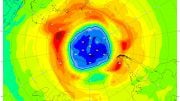
The study found that grimy windows can harbor potentially toxic pollutants.
The windows could be harboring toxic pollutants.
Dirty windows may harbor potentially harmful pollutants behind protective films of fatty acids from cooking emissions, which can linger for extended periods of time.
A recent study conducted by scientists at the University of Birmingham found that the fatty acids present in cooking emissions are extremely stable and difficult to break down in the atmosphere.
This means that when they collide with a solid surface, like a window, they create a thin, self-organized film that slowly accumulates and can only be gradually broken down by other chemicals in the atmosphere. The film will become rougher throughout this process and draw more water from the humidity in the air. Furthermore, harmful pollutants have the potential to become trapped within this resilient crust, where they are then shielded from breakdown in the atmosphere.
Senior author Dr. Christian Pfrang said: “The fatty acids in these films are not, by themselves, particularly harmful – but because they are not being broken down, they are effectively protecting any other pollutants that might be trapped underneath.”
The study, which was featured on the front cover of the journal Environmental Science: Atmospheres, was carried out in partnership with experts from the University of Bath, Diamond Light Source and ISIS Neutron and Muon Source in the UK, and the Institut Laue-Langevin in France.
The team worked on laboratory ‘proxies’ – samples of material engineered in the lab to approximate ‘real world’ samples. These were spun into super-thin films of pollution, just a few tens of nanometres in thickness.
The researchers used both neutrons and X-rays to study the nano-scale composition of the films and the changes in their surface structures. By changing the humidity and amount of ozone – a key pollutant indoors and outdoors – the researchers were also able to mimic the behavior of the films over time.
They found that the self-organized arrangement within the films in repeating molecular sheets – a so-called lamellar phase – made it difficult for smaller molecules, like ozone, to access the reactive parts of the fatty acids within these structures. Once deposited and exposed to ozone, the surfaces of the films became less smooth and increasingly likely to take up water, an effect which also has implications for the formation and lifetime of aerosols in the atmosphere.
Reference: “The evolution of surface structure during simulated atmospheric ageing of nano-scale coatings of an organic surfactant aerosol proxy” by Adam Milsom, Adam M. Squires, Maximilian W. A. Skoda, Philipp Gutfreund, Eleonore Mason, Nicholas J. Terrill and Christian Pfrangj, 25 May 2022, Environmental Science: Atmospheres.
DOI: 10.1039/D2EA00011C









Be the first to comment on "Scientists Reveal Why You Should Clean Your Dirty Windows"